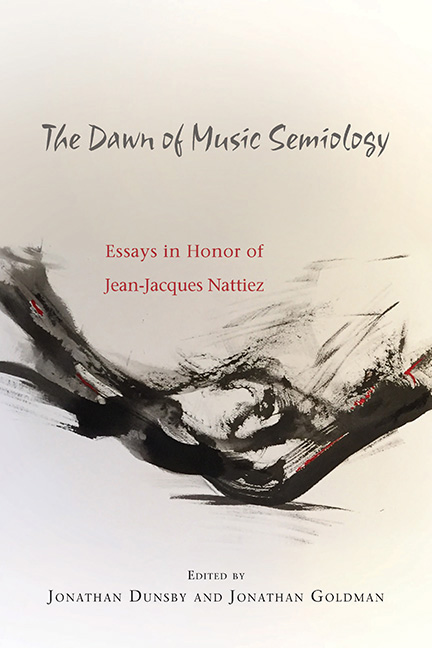Book contents
- Frontmatter
- Contents
- Foreword: About Jean-Jacques Nattiez
- Acknowledgments
- Introduction
- Part One Metaconsiderations
- Part Two Poietic Channels
- Part Three Esthesic Excursions
- 7 Musical Borrowings in the Works of Bruno Maderna
- 8 Of Doubles, Groups, and Rhymes: A Seriation of Works for Spatialized Orchestral Groups (1958–60)
- 9 The Psychological Organization of Music Listening: From Spontaneous to Learned Perceptive Processes
- Selected Bibliography of Works by Jean-Jacques Nattiez
- List of Contributors
- Index
- Tabula Gratulatoria
7 - Musical Borrowings in the Works of Bruno Maderna
from Part Three - Esthesic Excursions
Published online by Cambridge University Press: 26 April 2018
- Frontmatter
- Contents
- Foreword: About Jean-Jacques Nattiez
- Acknowledgments
- Introduction
- Part One Metaconsiderations
- Part Two Poietic Channels
- Part Three Esthesic Excursions
- 7 Musical Borrowings in the Works of Bruno Maderna
- 8 Of Doubles, Groups, and Rhymes: A Seriation of Works for Spatialized Orchestral Groups (1958–60)
- 9 The Psychological Organization of Music Listening: From Spontaneous to Learned Perceptive Processes
- Selected Bibliography of Works by Jean-Jacques Nattiez
- List of Contributors
- Index
- Tabula Gratulatoria
Summary
From the point of view of the listener, musical structures are objects distinguishable from other structures; from the point of view of the composer, they are the product of previous generations’ reflections on music, a link that makes comprehension between generations possible and that allows the expansion through time, place and genre of what is perceived as an element of a particular tradition. If a musical structure typical of a repertoire that is remote in space and time is utilized in a different context, its presence can achieve different results, since in the field of aesthetic perception and assessment the subjective parameters of the receivers—not only as single individuals but also as a group participating in a cultural area—are a non-negligible part of the communicative power of a cultural product. Moreover, every new composition is based on structures, that is to say musical forms, that emerge from previous generations. A new piece of music is like a constructive game in which tried and tested “forms” and practices are combined with newly invented ones, and in which composers’ creativity is expressed by their talent for combination much more than by their capacity to create completely new forms.
When hearing a piece for the first time, the listener likes both to feel at home—that is, able to recognize the forms and the ways they are combined— and to be surprised to encounter unexpected forms or new combinatory solutions. The composer—who is well aware of these communication mechanisms— sometimes uses structures with particular cultural connotations, associated with faraway eras or traditions, in this combinatorial game. Such objets trouvés are rarely quoted in the exact form they take in their original context; more often they are only hinted at, or more or less precisely imitated, so that the perception of their “alien” character in the new context, and the significance of their “alienation” can be very different. Moreover, some objets trouvés can adopt the grammatical rules of a particular style, that is, the rules necessary to give a particular form to a sequence without precisely coopting the object itself.
- Type
- Chapter
- Information
- The Dawn of Music SemiologyEssays in Honor of Jean-Jacques Nattiez, pp. 119 - 138Publisher: Boydell & BrewerPrint publication year: 2017

